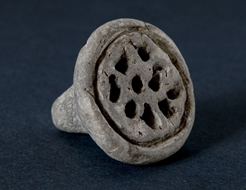|
||||||||||||||||||||||||||||||||
|
|
Museum of: Athens | |||||||||||||||||||||||||||||||
| Name of the artefact: Clay seal | ||||||||||||||||||||||||||||||||
|
Clay, conical seal with an incised circle and nine (9)
shallow holes on the sealing surface. It is dated in the Middle or the
Late Neolithic period ( 5800-5300 BC ). |
||||||||||||||||||||||||||||||||
|
WHERE IS IT AND MAIN CHARACTERISTICS |
STATE |
|||||||||||||||||||||||||||||||
|
Department: |
Prehistoric |
Preservation: |
Very good | |||||||||||||||||||||||||||||
|
Inventory number: |
6012 |
Restauration: |
No restored | |||||||||||||||||||||||||||||
|
Name of the artefact: |
Clay seal |
Completeness: |
Complete | |||||||||||||||||||||||||||||
|
Object type: |
Tool |
|||||||||||||||||||||||||||||||
|
Material: |
Clay |
|||||||||||||||||||||||||||||||
|
Methof of manufacture: |
Hand made |
|||||||||||||||||||||||||||||||
|
Decoration type: |
Incision |
|||||||||||||||||||||||||||||||
|
Distinctive mark: |
Sealing |
|||||||||||||||||||||||||||||||
|
DIMENSIONS |
PERIOD OF USE |
|||||||||||||||||||||||||||||||
|
Length (mm): |
- |
Epoque: |
Neolithic |
|||||||||||||||||||||||||||||
|
Heigth
(mm): |
29 |
Culture: |
Sesklo culture |
|||||||||||||||||||||||||||||
|
Diameter
(mm): |
31 |
Period: |
Middle Neolithic |
|||||||||||||||||||||||||||||
|
Width (mm): |
- |
Face: |
- |
|||||||||||||||||||||||||||||
|
Thickness (mm): |
- |
Absolute chronology: |
5800-5400BC |
|||||||||||||||||||||||||||||
|
Weight
(g): |
- |
|||||||||||||||||||||||||||||||
DISCOVERY |
||||||||||||||||||||||||||||||||
|
Date: |
1902 |
Country: |
Greece |
|||||||||||||||||||||||||||||
|
District: |
Thessaly |
Town hall affiliation: |
Volos |
|||||||||||||||||||||||||||||
|
Village: |
Sesklo |
Discovery findspot: |
Neolithic settlement of Sesklo |
|||||||||||||||||||||||||||||
|
Condition of discovery: |
Archaeological excavation |
Discovery type: |
Deposit |
|||||||||||||||||||||||||||||
|
ANALYSES – DETERMINATIONS |
FILLED IN BY |
|||||||||||||||||||||||||||||||
|
Type: |
- |
Name: |
Alexandra Christopoulou |
|||||||||||||||||||||||||||||
|
Laboratory: |
- |
Institution: |
National Archaeological Museum - Greece |
|||||||||||||||||||||||||||||
|
No./Code: |
- |
Date: |
21/11/2005 |
|||||||||||||||||||||||||||||
|
DEEPENINGS |
||||||||||||||||||||||||||||||||
|
Morphology of the object: |
||||||||||||||||||||||||||||||||
|
Conical seal made of grey clay. It is hand-made with
care though, because the surface was slipped and smoothed. So no finger
traces were left on it, as it has happened with other clay seals (such
as photo no 6013). The top of the cone has been pierced through,
obviously for suspension. The base of the cone was the sealing surface
bearing the design of the stamp. It is round and has got nine shallow
holes closed in an incised circle round the margin of the circular
surface. |
||||||||||||||||||||||||||||||||
|
Decoration: |
||||||||||||||||||||||||||||||||
|
- |
||||||||||||||||||||||||||||||||
|
Inscription: |
||||||||||||||||||||||||||||||||
|
- |
||||||||||||||||||||||||||||||||
|
Analogies: |
||||||||||||||||||||||||||||||||
|
The usual designs on seals in the greek neolithic era
are usually linear forming angles, steps, meanders or labyrinthoid
shapes (photos no 6013, 6016, all from Middle Neolithic Sesklo). The
design of this seal is until now unique, although there have been found
round seals the sealing design of which is circular in the form of a
spira or concentric circles. |
||||||||||||||||||||||||||||||||
|
Interpretation: |
||||||||||||||||||||||||||||||||
|
Seals, like figurines or ornaments / jewelery, can not
be included in the objects of everyday life for neolithic people. Their
existence should be connected with more complicated ideas, beyond food
and surviving needs. Unfortunately, there is no relevant evidence for
the inerpretation of seals, such as a sealing mark on vases or other
clay artefacts. Moreover, our knowledge on the structure of the
neolithic society, ruling systems or the commerce are obscure and
indirect. To the above, someone could add the inclination of the
researchers to interprete the function of seals according to the modern
/ recent way. Several functions for the seal use have been proposed: a)For
tatouase. It is the most probable use, since clay, when warmed at 100
degrees cg. is enough to create a stamp on the skin even without colour.
The zig-zag incisions on the shoulders of the marble figurine no. 3928
is a good example (mettere qui imagine 08). b) For designs on clothes,
although no seals with traces of coloured pigment have been found and c)
for designs on bread. In any case the hole of suspension prooves that
there existed an owner for this seal, who kept the seal suspended round
his neck / wrist and who used it for sealing either his personal
belongings or objects which were someone else’ s property. The latter
could mean either a wealthy person in the community or the community
itself (public property). Consequently, it should, also be a prestige
object. In fact, the number of seals found in the greek neolithic
settlements is small -around 25-, and the majority of them , 15 in
number,came from Sesklo. The site of Sesklo is an important settlement
in Thessaly, which, due to its large size and the high quality of its
artefacts, has been considered as the centre for several smaller
neolithic settlements around it. One could go further and suggest that
there existed a central communal kind of leadership responsible among
others for the storing of crops / products. To this activity the seal-
owner could be responsible for keeping records and take care of fare
distribution. The nine holes of the stamp could be a numerical
measurement. |
||||||||||||||||||||||||||||||||
|
Bibliography: |
||||||||||||||||||||||||||||||||
|
- |
||||||||||||||||||||||||||||||||

